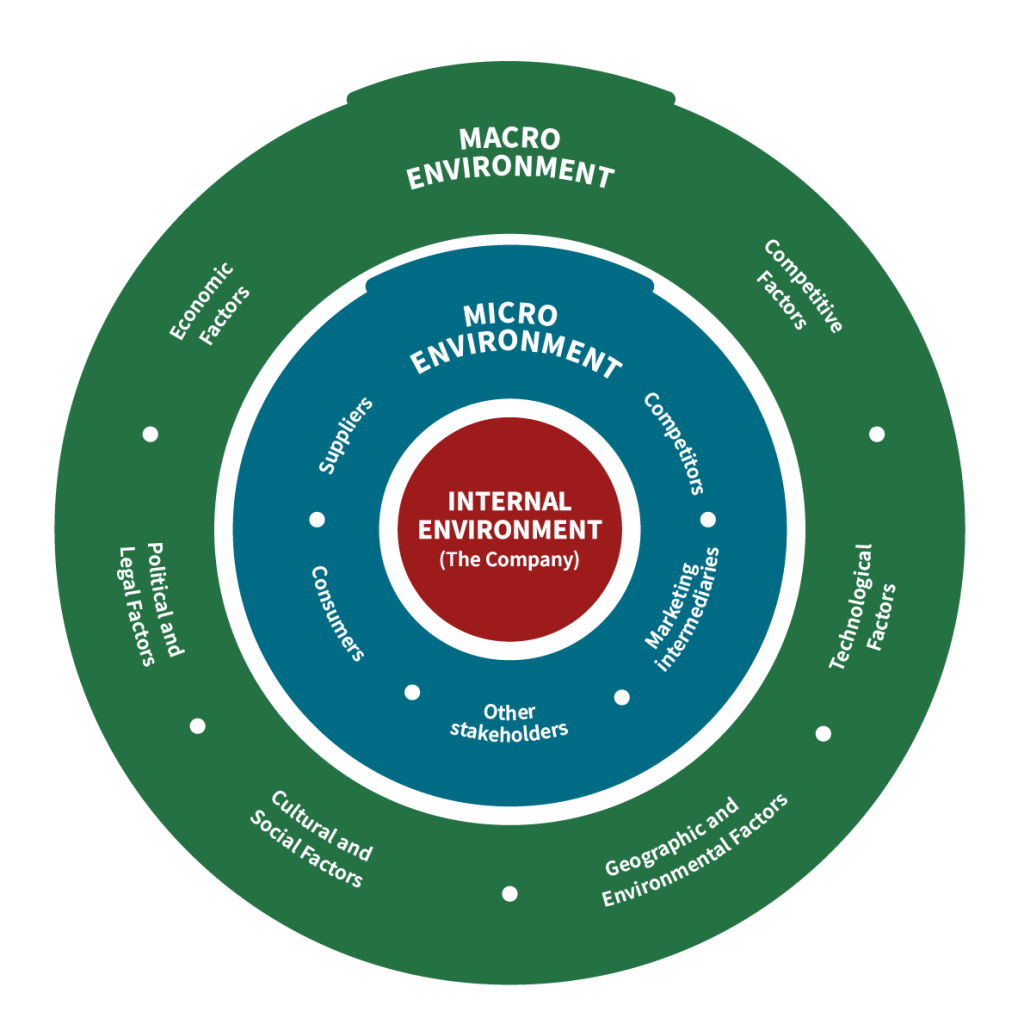6.1 The Relationship Between an Organization and its Environment
What Is the Environment?

Organizations don’t operate in a vacuum. They’re not self-contained, self-sufficient machines; they are complex systems that require interaction with facets of their internal and external environments to survive and prosper.
The marketing environment comprises the external and internal factors and forces that influence an organization’s decision regarding its marketing activities. Some of these factors—internal factors— are within the organization’s control. Other factors—external factors—are outside the control of the organization. In the case of Subway, for example, the environment contains its customers, its rivals such as McDonald’s and Kentucky Fried Chicken, social trends such as the shift in society toward healthier eating, political entities such as the U.S. Congress, and many additional conditions and forces.
It is useful to break the concept of the environment down into two components. The ‘General Environment or Macro-Environment’ includes overall trends and events in society, such as social trends, technological trends, demographics, and economic conditions. The ‘industry or competitive environment’ consists of multiple organizations that collectively compete with one another by providing similar goods, services, or both.
Every action that an organization takes, such as raising its prices or launching an advertising campaign, creates some degree of change in the world around it. Most organizations are limited in their influence on their industry. For example, Subway’s move to cut salt in its sandwiches may lead other fast-food firms to revisit the amount of salt contained in their products. A few organizations wield such power and influence that they can shape some elements of the general environment. While most organizations simply react to major technological trends, the actions of firms such as Intel, Microsoft, and Apple help create these trends. Some aspects of the general environment, such as demographics, simply must be taken as a given by all organizations. Overall, the environment has a far greater influence on most organizations than most organizations have on the environment.
Why Does the Environment Matter?
Understanding the environment that surrounds an organization is essential to the executives in charge of the organization. There are several reasons for this.
Resources
First, the environment provides resources that an organization needs to create goods and services. In the 17th century, British poet John Donne famously noted that “no man is an island.” Similarly, it is accurate to say that no organization is self-sufficient. As the human body must consume oxygen, food, and water, an organization needs to take in resources such as labour, money, and raw materials from outside its boundaries. Subway, for example, simply would cease to exist without the contributions of the franchisees that operate its stores, the suppliers that provide food and other necessary inputs, and the customers who provide Subway with money through purchasing its products. An organization cannot survive without the support of its environment.
Opportunities
Second, the environment is a source of opportunities and threats for an organization. Opportunities are events and trends that create chances to improve an organization’s performance level. In the late 1990s, for example, Jared Fogle’s growing fame created an opportunity for Subway to position itself as a healthy alternative to traditional fast-food restaurants. Threats are events and trends that may undermine an organization’s performance. Subway faces a threat from some upstart restaurant chains. Salad-works, for example, offers a variety of salads that contain fewer than 500 calories. Noodles and Company offers a variety of sandwiches, pasta dishes, and salads that contain fewer than 400 calories. These two firms are much smaller than Subway, but they could grow to become substantial threats to Subway’s positioning as a healthy eatery.
Decision Making
Third, the environment shapes the various strategic decisions that executives make as they attempt to lead their organizations to success. For example, the environment often places important constraints on an organization’s goals. A firm that sets a goal of increasing annual sales by 50 percent might struggle to achieve this goal during an economic recession or if several new competitors enter its business. Environmental conditions also need to be considered when examining whether to start doing business in a new country, acquire another company, or launch an innovative product, to name just a few.
Key Takeaway
An organization’s environment is a significant consideration. The environment is the source of resources that the organization needs. It provides opportunities and threats, and it influences the various strategic decisions that executives must make.
“1.3 Factors Comprising and Affecting the Marketing Environment” from Principles of Marketing by Rice University, OpenStax is licensed under a Creative Commons Attribution license unless otherwise noted.
“The Relationship between an Organization and Its Environment” from Mastering Strategic Management – 1st Canadian Edition by Janice Edwards is licensed under a Creative Commons Attribution-NonCommercial-ShareAlike 4.0 International License, except where otherwise noted.—removed extreme examples and exercises.

